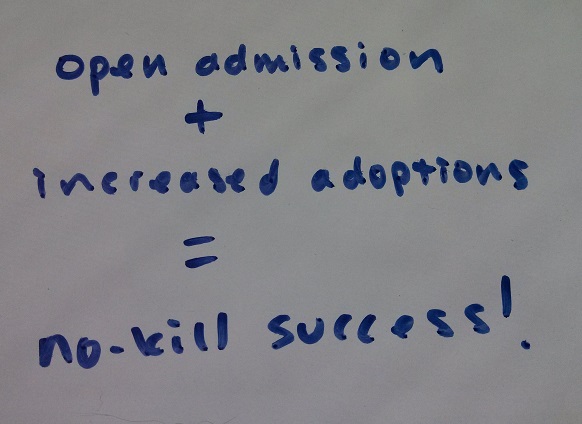
Any shelter or rescue group can call itself “no kill.”
While most readers of this blog have a good understanding of what a true no-kill shelter is, do you think the general public understands?
There are three kinds of shelters:
#1: Shelters that kill healthy dogs and cats
- Save some, kill the rest
Most shelters that kill dogs and cats “for space” are open-admission shelters, meaning they accept every incoming dog and cat. When they “run out of space,” they kill some to make room for more. They don’t call themselves “kill shelters,” of course.
They call themselves open-admission shelters, and they pat themselves on the back saying that “no-kill shelters” are still killing animals indirectly when they are full and have to turn animals away. This is false, because a true no-kill shelter is also open admission.
Some kill shelters are killing more than 50 percent of incoming animals with little effort to make improvements. They are run by directors who are uninformed or heartless and say no kill is “impossible.”
Other kill shelters are saving more and more pets each month and are working hard to achieve no-kill status. These are the kinds of open-admission shelters I like to support. They are trying to save more lives.
#2: “No-kill” shelters that are not open admission
- Place the blame somewhere else
These shelters or rescue groups call themselves “no kill” because they are not doing the actual killing. Once these shelters are full (and they are almost always full), they stop accepting more animals until space opens up.
Once these “no kill” shelters stop accepting pets, it means other groups feel the extra burden – the pounds, animal control, open-admission shelters and pet owners’ themselves.
Many of these healthy animals are eventually killed within the system. The killing is just not happening at these so-called “no kill” shelters.
While these “no-kill” shelters could get more creative by offering free cat adoptions, seeking additional foster homes or improving public relations, they instead choose to place the blame on “not enough homes” or “the economy” or “too many kittens” or whatever it might be.
These “no-kill” shelters are too picky about who can adopt, often requiring “home checks” on all adopters, along with $200+ adoption fees. Meanwhile the animals within their shelters wait for weeks, months or years for that “perfect” home. This is not what no kill is about.
These shelters are not looking at “no kill” as a community concept but as a “no kill” concept within their own organizations. This is a very shallow approach to “no kill”, and unfortunately the general public is sometimes fooled by the inaccurate “no-kill” labels these groups give themselves.
#3: True no-kill shelters that are open admission and no kill
- Accept all animals and work hard to make adoptions happen!
These are the best kinds of shelters because they are truly no kill. They do not kill healthy, non-aggressive dogs, and they do not turn away incoming pets.
Instead of killing some to make room for the rest or turning them away to be killed elsewhere, true no-kill shelters adopt their way out of killing.
True no-kill shelters increase adoptions by working with the public, reuniting lost pets with their owners, seeking additional foster homes, working with the media, offering adoption specials and so much more.
Organizations within a true no-kill community work together so no healthy, non-aggressive dogs or cats are killed anywhere within the community. They take equal share in the responsibility for the animals, without placing blame on other groups.
There are about 200 U.S. cities saving at least 90 percent of all impounded animals, according to Nathan Winograd, author of Redemption and executive director of the No Kill Advocacy Center.
These cities make up at least 50 no-kill communities. They have accomplished this by following the simple (but not easy!) no-kill equation.
Which type of shelter are you supporting?
Missy the black Lab and Itty Bitty the cat are up for adoption at Animal Allies Humane Society in Duluth, Minn. Animal Allies is a an open-admission, no-kill shelter, and Duluth is a no-kill community.




John
Thursday 6th of June 2013
So the tiny foster-based rescue group that is No Kill is somehow eeeeevil because two people with full time jobs who are rescuing animals in their spare time don't have the resources to be open admission?
C'mon now.
No Kill is an ethic, not a definition. That tiny rescue group can certainly be as No Kill as anyone - as can a standalone, limited admission shelter - some of whom take as much pressure as they can off of municipally supported facilities without, y'know, the tax money and municipal support.
Lindsay Stordahl
Thursday 6th of June 2013
Yes, I was a bit harsh, wasn't I? It was good to hear your opinion.
There is a fourth group that I failed to mention - the groups that are doing the best they can to save every animal, taking in as many as possible without killing. These groups are mostly small, private shelters and foster-based rescues, wouldn't you agree?
What I can't stand is when these small groups place such impossible adoption restrictions on the animals with high fees, home visits and so on. While I know many are moving away from this, others are getting more and more strict.
Mel
Monday 3rd of June 2013
There is one shelter near me that claims to be no-kill. However when they get full or animals just aren't being adopted, they send them to the kill-shelter a few minutes away. Of course the kill shelter gets a bad rep, while the "no-kill" shelter continues to look great to the public.
Ironically, I prefer the folks at the kill-shelter. At least they work with rescues.
Lindsay Stordahl
Monday 3rd of June 2013
Yes, I don't like how the "kill shelters" get the bad rap when the "no kill" groups are the ones turning animals away and often refusing to work with the public or with rescue groups.
jan
Monday 3rd of June 2013
Hopefully it won't be long before all shelters will be the third kind. Right now there needs to be more cooperation between them for the good of the animals.
Lindsay Stordahl
Monday 3rd of June 2013
Yes. Very true.